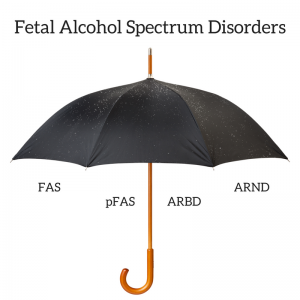Alcohol, Pregnancy & Fetal Alcohol Spectrum Disorders
Understanding Risks and Effects on a Developing Baby

A developing baby is exposed to the same concentration of alcohol as the mother during pregnancy. Baby’s brain, body and organs are developing throughout pregnancy—and especially in first weeks following conception. Alcohol exposure is unsafe for developing babies at every stage of pregnancy.
Of all the substances of abuse—including cocaine, methamphetamine, heroin and marijuana—alcohol produces by far the most serious neurobehavioral effects in a developing baby. 1
Alcohol in Pregnancy
Prenatal exposure to alcohol can cause damage to a developing baby at any time. Alcohol crosses the placenta within minutes, resulting in similar blood concentration in the baby as is present in the mother. As a teratogen—an agent that causes birth defects—alcohol is a toxic substance to a developing baby, and can cause:
- Premature and still birth
- Growth problems before and after birth (including being born small in both height and weight for their age, as well as having small heads).
- Physical birth defects
- Sudden Infant Death Syndrome (SIDS)
- Intellectual and behavioral problems
Exposure
The effects of alcohol on a developing baby primarily depend on the following:
- Quantity: How many drinks a woman consumes per occasion, such as binge drinking
- Frequency: How often a pregnant woman drinks
- Timing: What part or parts of the baby are developing at the time of the exposure
Other factors can also play a role in how prenatal alcohol exposure affects children. This includes:
- Poor maternal nutrition
- How quickly alcohol is metabolized in the mother
- Maternal age
Environmental Factors
Research demonstrates that children can be more affected by prenatal alcohol exposure if their mothers experience adverse-living conditions and high levels of stress. These may include: social isolation, living in circumstances where excessive drinking is common and accepted, and living in a community where resources for prenatal care are limited.
Genetics
The extent of alcohol’s effect on a developing baby may also depend on the mother’s genetic make-up, her child’s genetic make-up, and changes in gene activity caused by prenatal alcohol exposure.
The Fetal Alcohol Spectrum
 Alcohol consumption during pregnancy can cause a group of conditions called Fetal Alcohol Spectrum Disorders (FASD). FASD is an umbrella term to characterize the full range of damage from prenatal alcohol exposure, varying from mild to severe, and encompasses a broad array of physical, intellectual, learning, and behavioral disabilities. These conditions are lifelong and irreversible.
Alcohol consumption during pregnancy can cause a group of conditions called Fetal Alcohol Spectrum Disorders (FASD). FASD is an umbrella term to characterize the full range of damage from prenatal alcohol exposure, varying from mild to severe, and encompasses a broad array of physical, intellectual, learning, and behavioral disabilities. These conditions are lifelong and irreversible.
There is clear and compelling evidence that prenatal alcohol exposure negatively affects cognitive ability and behavior. Those affected by an FASD often have problems with learning and remembering; understanding and following directions; shifting their attention; and controlling their emotions. They may struggle with communication, socializing with others, and performing daily life skills like telling time, managing their money and being aware of dangers to personal safety. These problems may emerge early in life and continue to significantly impair an individuals’ functioning in a number of domains throughout the lifespan. While identified problems may be primarily attributed to brain damage due to alcohol exposure, the conditions can become apparent or exacerbated with interactional and environmental factors.
The Spectrum of FASD
The four categories of the FASD spectrum are Fetal Alcohol Syndrome (FAS), Partial FAS (pFAS), Alcohol Related Neurodevelopmental Disorder (ARND), and Alcohol-related Birth Defects (ARBD). Confirmation of prenatal alcohol exposure is required to determine all types of FASD, except for the most severe (FAS), which is determined by observable measurements taken by a trained pediatric specialist.
Fetal Alcohol Syndrome (FAS)
Fetal Alcohol Syndrome (FAS) is at the most severe end of the FASD range and is the most well-known FASD diagnosis. FAS was first described in medical literature by our Center’s own Dr. Jones in 1973. The prevalence of FAS is estimated to be 1 to 3 per 1,000 live births; this is roughly equivalent to the prevalence of Down Syndrome. A diagnosis of FAS requires the following:
- growth deficiency, as defined by height and/or weight being under the 10th percentile.
- a cluster of three specific facial malformations: small eyes, a thin upper lip, and a smooth philtrum (the area between the nose and the top of the upper lip).
- severe brain abnormalities; that is, either the physical size of the brain is small (a condition called microcephaly), there are abnormalities in specific structures of the brain, or there is evidence of neurological, intellectual and/or functional deficits.
- prenatal alcohol exposure (either confirmed or unknown).
Individuals with full FAS represent only a small portion of the FASD spectrum (that is, they are just “the tip of the iceberg”) and are generally recognized early due to the facial features and the severity of the symptoms. However, the majority of individuals affected by prenatal alcohol exposure do not meet all the above criteria. For example, they may have none of the physical features but still have cognitive and/or behavior deficits as a result of alcohol exposure. Terms given to these conditions include:
Partial FAS (pFAS)
Partial FAS (pFAS) is a diagnostic classification that includes some, but not all, of the physical characteristics of FAS but where there is evidence of severe brain abnormalities.
Alcohol Related Neurodevelopmental Disorder (ARND)
Alcohol Related Neurodevelopmental Disorder (ARND) requires evidence of both prenatal alcohol exposure and problems with neurocognitive development, adaptive function and/or behavior regulation, which can range from mild to severe. However, the physical characteristics (like the facial features and growth issues) are most often not seen in ARND.
Alcohol Related Birth Defects (ARBD)
Alcohol primarily affects the brain, but it can affect other organ systems as well. Those with ARBD may have problems with the heart, kidneys, bones, hearing, and/or vision. A diagnosis of Alcohol-Related Birth Defects (ARBD) requires evidence of both prenatal alcohol exposure and brain abnormalities, which may be structural or functional.
Recent Diagnostic Development in the Field of Mental Health: Neurodevelopmental Disorder associated with Prenatal Alcohol Exposure (ND-PAE)
Neurobehavioral Disorder Associated with Prenatal Alcohol Exposure (ND-PAE) is a new psychiatric diagnosis being considered that is included in the 5th edition of the Diagnostic and Statistical Manual of Mental Disorders (DSM-V), the handbook used by healthcare professionals to diagnose mental disorders. ND-PAE requires evidence of both prenatal alcohol exposure and impairments in the following three areas: cognition, self-regulation, and adaptive functioning. This new diagnosis will improve understanding of the multifaceted cognitive and behavioral deficits seen in some people exposed to alcohol prenatally, and facilitate diagnosis and treatment of these individuals.
 Institute of Fetal Alcohol Spectrum Disorders Discovery
Institute of Fetal Alcohol Spectrum Disorders Discovery
Paving the Way to a Better Tomorrow for FASD-Affected Families
Children, adults, and families who live with disabilities related to prenatal alcohol exposure face extraordinary challenges on a daily basis. The work of clinicians and researchers to understand and improve outcomes for these families is the focus of the Institute of Fetal Alcohol Spectrum Disorder Discovery at the Center for Better Beginnings. We have pioneered medical, educational, social, and scientific initiatives, all in pursuit of improving the quality of life for those affected and reducing the public health burden resulting from an FASD.
1 Institute of Medicine Report on Fetal Alcohol Syndrome Diagnosis, Epidemiology, Prevention and Treatment, 1996